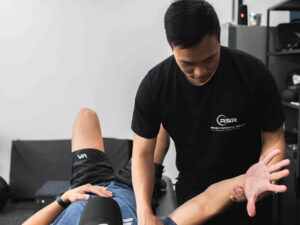Frozen shoulder, or clinically known as adhesive capsulitis, is one of the most debilitating things a person can go through. It’s marked by excruciating pain in the shoulder and limited range of motion in all directions. If you’re reading this, you probably have either experienced this, are currently suffering from it, or have known someone who has had it.
You might have heard a few things about this pathology, such as how it can last as long as a couple years, or how there are three stages of progression: freezing, frozen, and thawing. Sometimes it can happen out of nowhere (primary), or it can happen after surgery, trauma, or other pathology (secondary). It occurs most often in middle-aged women, and is often associated with co-morbidities such as smoking, obesity, thyroid issues, cardiovascular disease, and low levels of activity. The truth is, research and clinical treatment of frozen shoulder is still lagging and many patients continue to experience symptoms and functional limitations long after progressing through these stages. Though it is often regarded as a self-limiting disease that essentially goes away on its own after 1-2 years, many symptoms such as stiffness and pain persist in 20-50% of patients.
So, what exactly is happening with frozen shoulder? The shoulder joint capsule is made up of primarily fibrous connective tissue consisting of collagen. In frozen shoulder, these collagen fibers undergo gradual fibrosis, which causes thickening of the connective tissues and are accompanied by inflammation. This ultimately results in stiffness due to reduced joint volume that can restrict movement and cause pain. A host of physiological changes also occur in the neural and vascular tissue as a result of pro-inflammatory cytokines that I won’t cover in detail.
If you’ve had frozen shoulder and had PT for it, you were probably told that it would go away on its own. Then you probably received a long list of painful stretches to compliment the therapist cranking on your shoulder. For frozen shoulder, it’s not always about “no pain, no gain”, as that mentality can cause further inflammation. There are many ways to treat frozen shoulder, but from a physical therapist’s perspective, here are some of the things I have found to be most effective:
– Niel Asher Technique
– Myofascial decompression with movement
– Manipulation of the cervical and thoracic spine
– Proprioceptive pumping to address muscle guarding
– Gentle stretching with transcutaneous electrical nerve stimulation
– When appropriate, resistance-based exercise also plays an important role in addition to a multimodal program.
Besides interventions that specifically target the shoulder, general physical activity is recommended for overall health, well-being, and improving mood and sleep. If non-operative management has failed, operative management, such as manipulation under anesthesia or arthroscopic capsular release, can provide an improvement in pain, range of motion and function. However, there’s a chance that what you’re experiencing is not true frozen shoulder, but rather a stiff and scared shoulder. Please, do yourself a favor and get assessed by a good physical therapist. At Renew Sports Rehab, we have seen over 50 cases of frozen shoulder and can help you determine what you’re experiencing and how to recover from it. We would love to collaborate with you to get your shoulder back!

#frozenshoulder #adhesivecapsulitis #stiffshoulder #manipulationunderanesthesia #physicaltherapy


